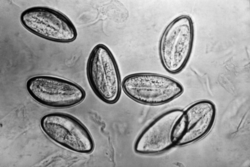Enterobiasis
Enterobiasis (also known as oxyuriasis[1]) is a parasitic disease caused by Enterobius vermicularis. In some areas, it affects up to 40% of the population. Occurrence is cosmopolitan, not tied to the hygienic standard. It is rare in the tropics, but more common in the temperate zone.
- Life cycle
mature egg → larva → maturation in caecum → copulation → migration into the anus → laying eggs
In two to four hours, the larva in the rectum is mature → the possibility of auto-infection during the subsequent itching and re-insertion of the larvae with the fingers into the oral cavity.
- Spread
Man is the only host. The infection is fecal-oral, in direct contact with the infected person.
- Complications
Lifespan 30-45 days, so reinfections are a problem. Girls are at risk of genital inflammation. Extensive infection can lead to appendix oxyuriasis, which can manifest as appendicitis.
Clinical picture[edit | edit source]
- The course is mild or asymptomatic, mostly asymptomatic;
- nocturnal perianal itching → insomnia → irritability, restlessness
- perianal pruritus is common;
- risk of infections in girls → carry intestinal bacteria → "oxyur nodules" in the uterus.
Diagnostics[edit | edit source]
- Perianal swabs before bathing and washing;
- Perianal print on adhesive tape - to identify the eggs (at night the adhesive tape sticks to the surroundings of the anus, the worms then climb out at night and lay eggs, which become attached to the adhesive tape, which is then examined under a microscope).
Therapy[edit | edit source]
- Exceptionally;
- the main drug is Pyrvinium - given as a single dose - 5 mg / kg;
- the product dyes intensely red stools and linen;
- it is recommended to treat all family and team members at the same time;
- mebendazole, albendazole.
Links[edit | edit source]
Related articles[edit | edit source]
Source[edit | edit source]
- BENEŠ, Jiří. Studijní materiály [online]. ©2007. [cit. 2009]. <http://www.jirben.wz.cz/>.
References[edit | edit source]
1. BENEŠ, Jiří, et al. Infekční lékařství. 1. vydání. Galén, 2009. 651 s. s. 349, 350. ISBN 978-80-7262-644-1.
2. VELKÝ LÉKAŘSKÝ SLOVNÍK,. Oxyuriáza [online]. [cit. 2018-03-20]. <http://lekarske.slovniky.cz/pojem/oxyuriaza>.
- ↑ VELKÝ LÉKAŘSKÝ SLOVNÍK,. Oxyuriáza [online]. [cit. 2018-03-20]. <http://lekarske.slovniky.cz/pojem/oxyuriaza>.




